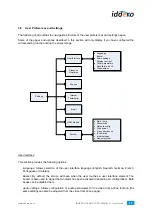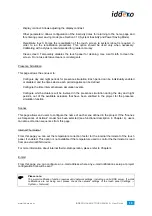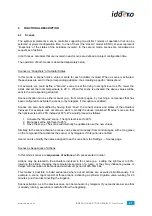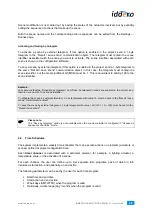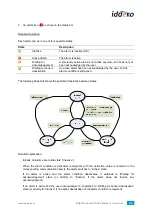
www.iddero.com
IDDERO HCx-KNX TOUCH PANELS – User Guide
28
I
1
I
2
I
3
I
4
AND
OR
XOR
NAND
NOR
XNOR
1
0
0
0
0 1 1 1 0 0
1
0
0
1
0 1 0 1 0 1
1
0
1
0
0 1 0 1 0 1
1
0
1
1
0 1 1 1 0 0
1
1
0
0
0 1 0 1 0 1
1
1
0
1
0 1 1 1 0 0
1
1
1
0
0 1 1 1 0 0
1
1
1
1
1 1 0 0 0 1
Additionally, all logic gates support an
output filter
that can be used to restrict the type of values sent
to the output: All values, only “ON” telegrams (1), or only “OFF” telegrams (0).
Multiplexers and Demultiplexers
Multiplexers are elements with multiple inputs and one output where one of the inputs is connected to
the output, based on a control signal. Demultiplexers are elements with one input and multiple outputs
where the input is connected to one of the outputs, based on a control signal.
They can be used with any KNX data type (1-bit objects, 1-byte objects, etc.).
Multiplexers and demultiplexers can be 2-channel or 4-channel devices. The “control signal” consists
of a 1-bit object for 2-channel devices, and of two 1-bit objects for 4-channel devices.
The following logic tables show the operation of multiplexers and demultiplexers in detail (I
x
= Input
“x”, C
y
= Control object “y”, Q
z
= Output “z”)
MUX2
MUX4
DEMUX2
DEMUX4
C
Function
C1
C2
Function
C
Function
C1
C2
Function
0 Q
=
I
1
0 0 Q
=
I
1
0 Q
1
= I
0 0 Q
1
= I
1 Q
=
I
2
0 1 Q
=
I
2
1 Q
2
= I
0 1 Q
2
= I
1 0 Q
=
I
3
1
0 Q
3
= I
1 1 Q
=
I
4
1
1 Q
4
= I
Delay Units
Delay units are elements that retransmit any telegram received via their input communication object,
after a certain configurable delay.
They can be used with any KNX data type.
The behaviour of a delay unit in case of
event overlapping
(reception of a new input telegram while
the previous telegram is still being processed) can be configured via the parameter with the same
name: The delay unit can be configured to discard any telegrams received while the delay unit is busy




